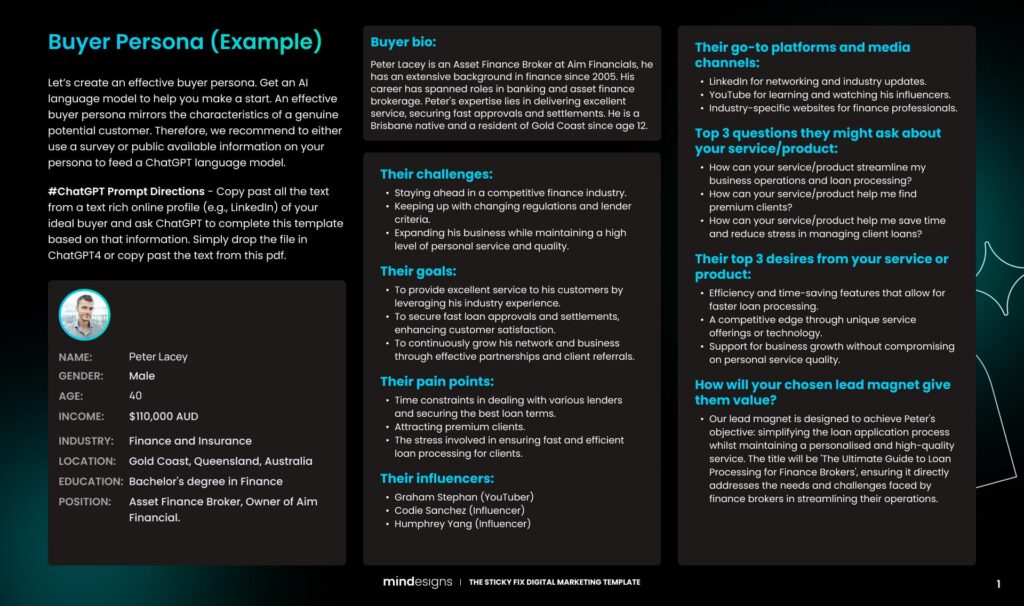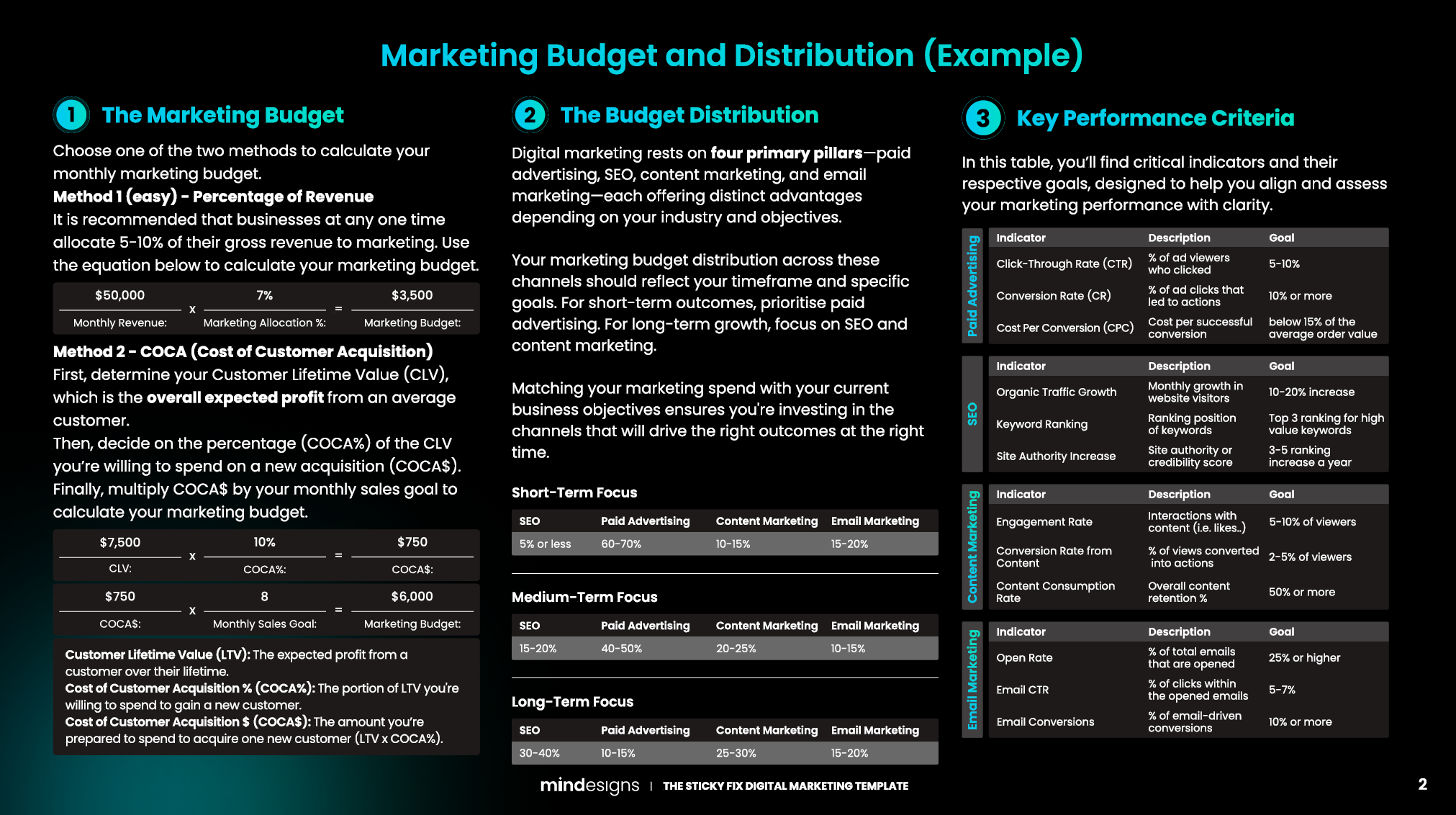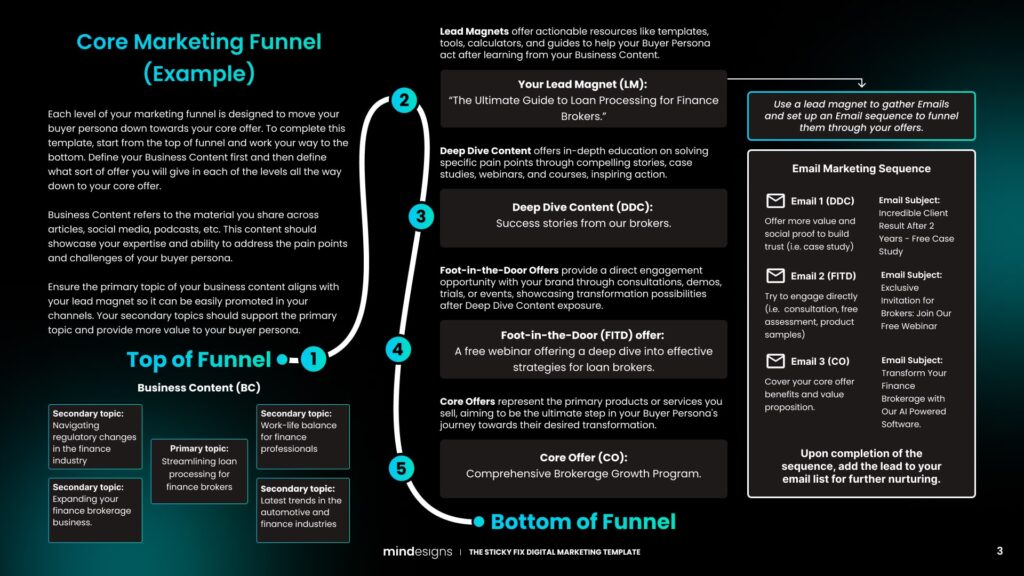Digital marketing for schools presents its own unique set of challenges. However, after helping several education providers succeed online, we’ve compiled key insights to make your marketing journey easier and help you avoid critical mistakes.
We are not going to sugar coat it, to create an effective marketing strategy, you need to understand your target demographic thoroughly, possess relevant marketing experience, and have a well-defined plan. However, today, we will aim to help you streamline this process.
As you know, your clients (parents or Uni students) require a little more nurturing. Therefore, we need to get our branding perfect and adopt a more comprehensive funnel approach, similar to the one we developed in our digital marketing template.
Download Our Free Digital Marketing Template
Whether you want to increase student enrollment or enhance your school’s reputation, this article, along with our template, is guaranteed to help you create a better marketing plan.
Digital Marketing Strategy for Educational Businesses
Digital marketing for schools is constantly evolving. For example, at the time of writing this article, Google Maps has recently decided to remove all Google Reviews from primary and secondary schools in Australia.
Imagine the pain for schools that put a lot of effort into getting reviews, only to have them all disappear. In essence, we cannot control everything online, but we can control our visual presence and what our school represents. You will soon discover why this holds great significance.
In today’s digital age, deploying a robust digital strategy is no longer optional, it’s a must. Did you know that one-half to three-quarters of today’s parents and university students choose their school based on an online search? Forget about flyers and static billboards. The key to establishing a successful school is to effectively define your school online, who it serves, what it offers, and how it is different. We will dive into this very shortly, and how to do it effectively. But first, a little about our template.
The idea behind our downloadable template is to give you a well-tested digital marketing structure that you can easily complete using ChatGPT. Even individuals without extensive marketing expertise can still create a decent digital strategy by following the recommendations in this article.
This article will guide you through the template and provide extremely relevant considerations for digital marketing in schools. Let’s get into it.
Page One – The Customer Persona
When you understand what drives your ideal students and their parents, your marketing becomes more targeted and effective. A clear customer profile enables you to effectively address their needs and present your school as a trusted and attractive choice.
Completing the first page of the template will provide a clearer picture of your audience. So you can:
A. Pinpoint their goals, challenges, and pain points in your communication.
B. Understand what they’re looking for and what kind of lead magnets (such as a digital brochure or class guide) could encourage them to share their contact details.
C. Get a sense of which platforms they’re on so you can reach them through paid ads.
These insights will help you write your marketing material, but more than that, they will also help you select appropriate images and visuals to use online. Whether on your website or paid ad campaigns. Nailing this combination of copy and visuals is key.
You can complete this page on your own or drag and drop the template into ChatGPT, provide it with some context about your ideal client, and ask it to complete the first page of the buyer persona. There is no perfect prompt, but we recommend you follow this format –
Prompt format – (Action: complete the first page of the buyer persona), (context: give some details about who your ideal buyer persona is and your school)
Important tip: if your target audience includes students or parents from a specific cultural background, your website visuals should reflect that. For instance, if your school serves a predominantly Asian community, ensure that your imagery and design elements resonate with that audience. If your school is more multicultural, highlight diversity in your visuals. It may seem subtle, but these choices have a significant impact on how families perceive your school.
This targeted approach to understanding your audience lays the groundwork for a marketing strategy that effectively draws your target students and parents to enroll in your school.
Page Two – The Educational Marketing Budget and Distribution
This part of the template is less about getting ChatGPT to help you complete it and more about making informed decisions regarding your marketing budget and selecting the proper channels based on your needs. Let’s break this page down.
Part 1 – Marketing Budget Calculation for Your School
You’re given two easy-to-follow methods to calculate your marketing budget:
-
-
Method 1: A simple percentage of your revenue (ideal for quick estimates).
-
Method 2: Based on your Cost of Customer Acquisition (COCA), giving a more strategic view rooted in customer value and growth targets.
-
Part 2 – Budget Distribution by Timeframe
The template breaks down how to allocate your budget depending on whether you want short-term wins (if revenue is urgent), medium-term growth, or long-term sustainability:
-
Short-Term Focus leans heavily on paid advertising.
-
Medium-Term Focus introduces a more balanced approach across SEO, content, paid advertising, and email marketing.
-
Long-Term Focus prioritises SEO and content marketing, which compound over time.
Part 3 – Performance Indicators to Aim For
Lastly, the page includes Key Performance Indicators (KPIs) for each strategy: Paid Advertising, SEO, Content Marketing, and Email Marketing. This information provides clear benchmarks for what ‘good performance’ looks like. These goals will help you measure your marketing impact and spot areas for optimisation.
Page Three – Digital Marketing Funnel for Schools
The marketing funnel is all about leading a cold audience (people who have never heard about your school) all the way to clients who have enrolled. It’s a concept that offers structure for marketers to create relevant content for each stage of the customer journey. If you don’t adjust your message for where your audience is in the journey, cold or warm, you’re setting your marketing up to fail.
The marketing funnel begins at the top, where we spark interest through engaging online content on social media, news articles, or similar platforms that showcase your school’s strengths and educational philosophy. This initial step involves drawing in prospective students and their families to learn more about what you offer.
Next, we incorporate lead magnets, like informative digital brochures or interactive virtual school tours. These resources aim to provide value and foster deeper exploration of your school’s offerings. As interest grows, in-depth content such as detailed program descriptions, success stories, and educational webinars offers a closer look at how your school meets their educational needs and aspirations.
The strategy then introduces opportunities for direct interaction, including online consultations, virtual open days, or sample classes. These interactions are pivotal in showcasing the unique benefits and community that your school offers.
The ultimate objective of this marketing funnel is to guide potential families and students towards enrolling, effectively focusing your digital marketing efforts on those most likely to join your school community.
Similar to the first page, provide ChatGPT with some context. You can literally copy and paste the buyer persona it generated for you earlier and ask it to complete the core marketing funnel. Again, there is no perfect prompt, but we recommend you follow this format –
Prompt format – (Action: complete the third page of the core marketing funnel) (context: use the customer persona details you previously generated and give some details about your school)
Page Four – Crafting a School-Focused Digital Communication Strategy
The Digital Communication Strategy page provides a systematic method for devising a strategic plan for your digital outreach, with a particular emphasis on selecting the optimal communication channels. Central to this approach is a nuanced understanding of where potential students and their families are most active and receptive online (Facebook, Instagram, etc).
Parents and mature uni students probably hang out on different platforms, so there is no perfect combination. However, based on our experience, some of the more effective channels for advertising your school include Google Ads and Facebook Ads.
You could also test ChatGPT and see what it recommends.
Similar to the previous examples, provide ChatGPT with some context. Include your buyer persona information in the prompt and ask it to tailor a communication strategy that suits –
Prompt format – (Action: complete the fourth page of the marketing channel strategy) (context: use the customer persona details you previously generated and ask ChatGPT to build a communication channel that would be effective)
ChatGPT can offer great ideas, but don’t take everything at face value. Use your judgment and think critically when applying any concept to your marketing strategy.
Tailoring Digital Communication for Schools
The communication approach for a warm audience, such as individuals who are already familiar with your school, should focus on showcasing core offerings. This could involve virtual open days, one-on-one consultations, or special enrolment offers designed to cater to those who are on the verge of choosing your school.
In contrast, engaging cold audiences who are not familiar with your school requires a strategy aimed at building initial awareness and trust. This necessitates leveraging platforms where these potential students and their families are likely to spend time, such as social media channels, and through resources like eBooks or informative webinars. This is a more subtle approach, with the goal of introducing them to what makes your school unique.
Social media platforms are particularly effective in reaching cold audiences for the first time, serving as a critical tool for raising awareness. Additionally, optimising your school’s website for SEO is crucial in generating organic traffic ready to enroll, thereby enhancing your school’s visibility for warmer audiences.
Identifying and utilising the right communication channels at each funnel stage is essential for the efficacy of your strategy. By downloading our template, you’ll gain valuable insights into tailoring your digital communication strategy to effectively leverage the strengths of each channel, ensuring that your school connects with potential students and parents where they are most engaged.
Digital Marketing for Schools needs to be Cohesive
Every page of your strategy should align, from how you define your audience to the visuals and messaging you use across your website and ads. Our template will help you connect these elements into a clear, unified strategy. Building a cohesive approach ensures that parents and students experience consistent, relevant communication at every stage of the journey. This will build trust, improve enrolment outcomes, and strengthen your school’s online presence.
Marketing Tips for Schools:
Here is how you can stand out much better than most schools in Australia –
Leverage Social Media for Storytelling: Use platforms like Instagram and Facebook to share the success stories of current students and alumni, showcasing the real impact of your educational programs.
Optimise for Local SEO: Many parents and students search for educational institutions within their local area. Ensure your school appears at the top of Google Search and Google Maps results by optimising your website and content for local SEO.
Use Video Content: Video tours of your campus, interviews with faculty, and student testimonials can significantly boost trust, engagement, and help prospective students and their parents feel connected to your school.
Engage in Community Events: Hosting or participating in community events can increase your institution’s visibility and demonstrate your commitment to the local community.
Implement Email Marketing Campaigns: Keep prospective and current students and parents informed with regular updates about your institution, upcoming events, and program offerings through targeted email campaigns.
By following these guidelines, you will craft a powerful strategy that ultimately drives enrollment and success. If you’re seeking a complimentary strategy session, book us today.



























































